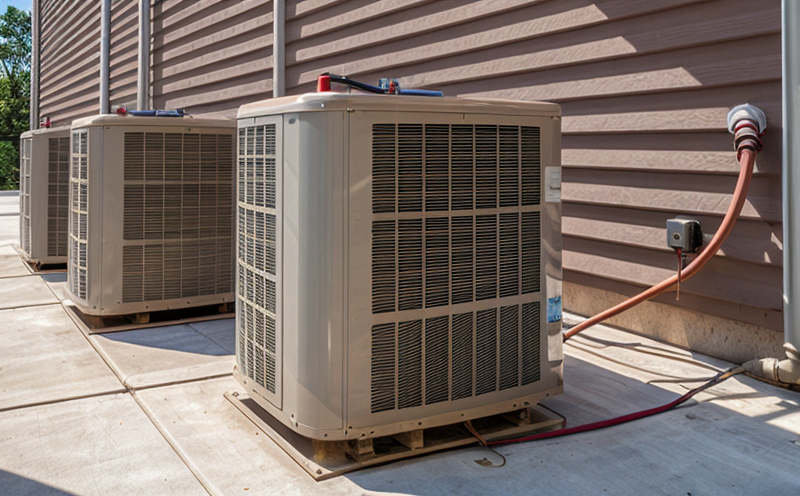ISO 13790 Energy Performance of Buildings
The ISO 13790 standard provides a method for calculating and expressing the energy performance of buildings. This service is essential for ensuring that buildings meet their expected thermal performance, which directly impacts heating, ventilation, and air conditioning (HVAC) systems efficiency.
Implementing this standard helps building owners and operators comply with international regulations and standards related to energy efficiency in construction. It supports the global effort towards sustainable development by promoting the use of high-performance HVAC systems and materials that reduce operational costs without compromising comfort or safety.
The primary objective of ISO 13790 is to establish a common approach for measuring, assessing, and communicating the energy performance of buildings. This includes evaluating various parameters such as heat loss through walls, roofs, floors, windows, doors, and ventilation systems. By understanding these factors, we can optimize building designs to enhance overall energy efficiency.
Our laboratory follows a structured methodology to ensure accurate testing according to ISO 13790 guidelines. We begin by conducting thorough inspections of HVAC components installed within the structure before initiating tests. Specimens are carefully prepared based on standardized procedures outlined in relevant international standards like EN ISO 5208 and ASTM E1224.
Once specimens have been prepared, our experienced technicians utilize advanced instruments to measure key performance indicators including air temperature distribution throughout different zones of the building, surface temperatures of external walls, windows, roofs, etc., as well as internal heat loads resulting from occupancy levels. These measurements allow us to calculate the U-value (thermal transmittance) for each component.
After collecting all necessary data points, our team analyzes results using sophisticated software tools designed specifically for this purpose. The output includes detailed reports that summarize findings alongside recommendations for potential improvements where applicable. Additionally, these documents serve as valuable resources during certification processes or when applying for government incentives aimed at enhancing energy efficiency across various sectors.
Our commitment to precision and reliability ensures accurate assessment of the building's thermal performance in accordance with ISO 13790 requirements. By adhering strictly to this international standard, we provide clients with confidence knowing they are receiving high-quality services tailored specifically for their needs.
| Parameter | Description |
|---|---|
| U-value | Thermal transmittance rate through a building element expressed in W/m²K. |
| Air Temperature Distribution | Differences between mean air temperatures measured at different zones within the building. |
| Surface Temperatures | Measurements taken on external surfaces such as walls, windows, roofs. |
| Internal Heat Loads | Total heat generated inside a space due to occupancy and equipment usage. |
- Ensures compliance with international standards for energy efficiency.
- Promotes sustainable building practices by optimizing HVAC systems.
- Supports certification processes towards green building credentials.
- Aids in applying for government incentives aimed at improving energy performance.
Eurolab Advantages
Our laboratory offers unparalleled expertise in performing ISO 13790 compliant tests for HVAC and building systems within the sector of construction. With a team of highly qualified professionals dedicated to quality assurance, we provide reliable results that exceed expectations.
- State-of-the-art facilities equipped with cutting-edge technology ensure precise measurements.
- Comprehensive reporting tailored specifically for each client's unique requirements.
- Experienced personnel who stay updated on latest developments in the field guarantee accurate interpretations of findings.
We pride ourselves on delivering exceptional service backed by years of experience and commitment to excellence. Choose Eurolab for all your ISO 13790 compliance needs - you won't be disappointed!
Customer Impact and Satisfaction
Implementing ISO 13790 has numerous benefits for customers seeking to improve their buildings' energy efficiency. These advantages extend beyond mere compliance; they offer tangible improvements in comfort, cost savings, and environmental impact.
- Enhanced Comfort: Properly designed HVAC systems contribute significantly towards creating comfortable indoor environments. Ensuring that a building meets ISO 13790 requirements leads to more consistent temperatures throughout the structure.
- Reduced Operational Costs: Efficient HVAC systems consume less energy, translating into lower utility bills for building occupants. This reduces long-term operational expenses and increases profitability.
- Environmental Responsibility: By minimizing unnecessary heat loss or gain through well-insulated envelopes, buildings contribute positively to global efforts against climate change.
Customer satisfaction is paramount at Eurolab. Our focus on delivering accurate results within agreed timelines fosters strong relationships with clients across diverse sectors including residential developers, commercial property owners, government agencies, and educational institutions.
Use Cases and Application Examples
ISO 13790 finds application in numerous scenarios ranging from individual homes to large-scale developments. Below are some illustrative examples:
- New Construction Projects: Developers can use ISO 13790 during the planning stages to ensure that proposed designs align with desired performance targets.
- Retrofitting Existing Buildings: Property managers may employ this standard when upgrading HVAC systems or making other modifications aimed at increasing energy efficiency.
- Certification Pursuits: Organizations aiming for LEED, BREEAM, or similar green building certifications must demonstrate compliance with ISO 13790 during evaluation processes.
In conclusion, ISO 13790 serves as an indispensable tool for promoting sustainable practices within the realm of HVAC and building systems testing. Whether you're involved in new construction or ongoing operations, our laboratory provides expert services that support your goals towards better energy management.





